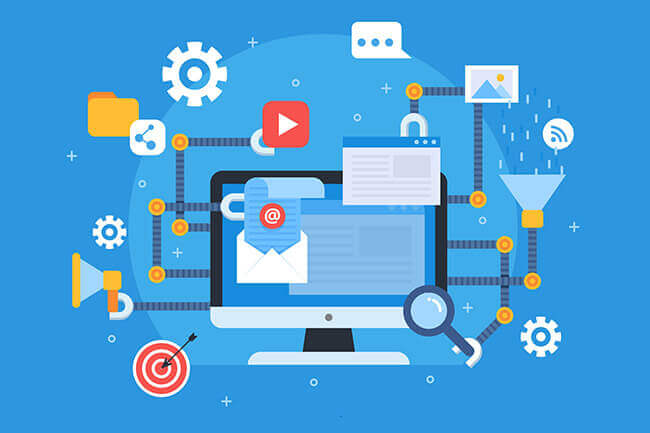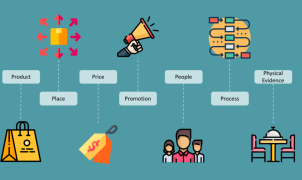Every day, consumers are bombarded with communication messages from various channels. Consequently, making a brand’s marketing campaign stand out among countless competitors has become more challenging than ever. With the advancement of technology, Marketing automation tools have emerged to address this challenge.
1. Overview of Marketing Automation
1.1. What is Marketing Automation?
Marketing automation involves organizing, automating, measuring marketing tasks and workflows to enhance efficiency and drive revenue faster. Businesses aim for higher revenue and faster growth with lower costs. However, many companies still struggle to achieve these goals, especially in coordinating human elements, processes, and technology. Thus, Marketing automation has emerged to help businesses tackle these challenges.
This tool is designed to enable businesses to deploy marketing activities across multiple channels more effectively and automate repetitive tasks.
Marketing automation brings several benefits to businesses such as:
- Boosting lead generation
- Segmenting target markets
- Relationship marketing
- Upselling and cross-selling
- Measuring return on investment (ROI)
- Account-based marketing

1.2. What is the Importance of Marketing Automation?
Initially, marketing automation was only applied in large enterprises. However, recently, automation tools have become more popular and can be extended to small and medium-sized businesses.
It’s not surprising that marketing automation has transitioned from an optional tool to essential for all businesses. Statistics indicate:
- Marketing automation technology is expected to show a compound annual growth rate (CAGR) of 14% over the next 5 years.
- Growth rates for “marketing automation through media channels” are projected to reach 25% annually. Meanwhile, for “revenue-driving automation platforms,” it’s 19.4%.
2. Benefits of Marketing Automation
Considering the common challenges businesses face, attracting and retaining potential customers throughout the buying journey remains a top priority. Along with these goals, businesses also have to deal with the data explosion but struggle to utilize it effectively.
2.1. Attracting Potential Customers
Finding and attracting potential customers is crucial for business growth. By automating processes from marketing to sales, businesses will have more time to focus on overall strategies and nurturing potential customers.
Marketing automation provides businesses with a detailed picture of potential customer behavior. This tool will use tracking methods, such as monitoring users’ journeys through the website, to help marketers understand potential customers’ preferences and exactly where they are in the buying cycle.
For instance, if a specific customer is researching various product types, narrowing down their choices, and seeking information about a particular product, it means they’ve narrowed down their options and are ready to contact sales representatives.
Collecting information from touchpoints such as website visits, social media activities, and direct marketing enables marketing automation tools to score, evaluate, and prioritize potential customers. This can then drive broader marketing campaigns.
2.2. Improving ROI
Besides attracting potential customers, marketing automation allows businesses to establish clear, objective metrics about the customer lifecycle. Whereas previously, assessing a potential customer’s readiness could rely solely on a marketer’s intuition, now it can be based on predetermined results and measured by automation tools.
With such focused analysis, marketing automation can support sales teams, saving them more working time, measuring the effectiveness of customer interactions, and establishing overall campaign efficiency.
Predictions based on intuition are entirely eliminated from the process, especially decisions regarding when an individual potential customer transitions to a buying decision. Indeed, specific reports will allow businesses to accurately calculate costs per opportunity and ROI of specific marketing efforts.
2.3. Personalized Workflow
Every action of a potential customer is additional data points for a business’s marketing strategy. It allows them to know what customers are looking for and need. To track and collect this information regularly, businesses can’t rely on conventional manual methods.
Thus, marketing automation software helps businesses use this input across multiple channels. This provides deep insights into customer needs and delivers appropriate content at the right time.
These workflows will help potential customers access the right useful content they are looking for, gradually nurturing them into customers and decision-makers.
However, marketing automation doesn’t stop there. With the customer at the center, businesses can continue to attract customers through personalized workflows. To lead, attract them to become loyal customers.
3. Optimizing Marketing Automation Tools
Marketing automation is a combination of technology, strategy, and customer-centricity.
It enables businesses to nurture potential customers with highly personalized content, converting potential customers into customers. Making them satisfied and turning them into loyal customers.
To optimize marketing automation tools, businesses should integrate automation into their entire business operations. To break down silos and consolidate teams through time-saving processes.
Combined with human contact, marketing automation can further help businesses grow in the future. To get started, businesses need to think about their goals and how they will achieve them. Additionally, they need to identify which processes require marketing automation.
Step 1: Planning.
Identifying precisely what you are looking for and what you are trying to accomplish will make it easier for businesses to evaluate and select an automation platform. Make a list of needs and desires, then consider which solution meets the most essential criteria.
At this stage, businesses need to ensure alignment between sales and marketing revenue. The departments need to closely collaborate to create efficiency in work.
Step 2: Implementation.
After selecting the appropriate automation platform, choose a resource team to handle this work and train them carefully. These employees need to understand technology applications. Answer any customer questions and within the workflow.
An appropriate marketing automation solution will help integrate everyone, tools, and processes in marketing and sales teams, including:
- CRM system
- Lead scoring
- Sales information
- Interdepartmental workflows
Once marketing automation tools are deployed, businesses need to check regularly. This will ensure that activities are happening as desired and originally intended.
Step 3: Measurement.
Specific reports and analysis will help businesses demonstrate the impact of deployed marketing efforts. However, it’s essential to ensure that all necessary data has been measured. This includes account interaction levels and the impact of sales and marketing activities.
Moreover, it’s necessary to understand which key performance indicators (KPIs) are most important to monitor and which marketing fields provide the best ROI.
Step 4: Optimization.
By accurately identifying KPI data, businesses will easily optimize tools for better results. Controlling KPIs throughout the process will help businesses know which marketing activities are effective and which activities are stagnating.
For example:
A business identifies that event marketing is its goal. And trade shows are one of the best options for attracting potential customers. While webinars are more effective in pushing potential customers through the channel.
4. How Does Marketing Automation Impact Consumers?
Marketing automation not only benefits businesses but also helps their customers solve common challenges in the digital age. Customers are overwhelmed by too much information, making them feel confused when they need to find truly relevant answers.
Once customers have made product choices, they often have to undergo disjointed experiences. Because they have to constantly switch between different platforms, channels. Marketing automation can minimize this disjointedness by connecting platforms. It collects data in a usable format and prioritizes important tasks.
- Display more relevant content
With marketing automation, businesses can specify exactly what customers will see when they visit the website. From advertisements to email marketing, leverage customer portraits. Study their behavior to provide the information they need. Additionally, marketing automation helps businesses save unnecessary time by using collected data to highlight the most relevant content at the right time.
- Provide better, faster answers
In addition, marketing automation helps businesses prioritize tasks and manage potential customers. Therefore, customer questions are answered more quickly. The goal is to use information gathered in the customer database to provide the most accurate and relevant answers.
- Improve the overall customer experience
In conclusion, marketing automation can help improve the overall customer experience. By providing better content and faster answers, customers will feel that businesses understand their needs. Consequently, they are more likely to become loyal customers.
Conclusion
As technology continues to evolve, businesses need to adapt to stay competitive. Marketing automation is an essential tool for any modern business seeking to optimize its marketing efforts. By leveraging automation tools effectively, businesses can attract, engage, and retain customers more efficiently, ultimately driving revenue growth and improving the overall customer experience. However, successful implementation requires careful planning, implementation, measurement, and optimization. With the right strategy and tools in place, businesses can unlock the full potential of marketing automation and achieve their growth objectives in today’s fast-paced digital landscape.
Cre: cleverads



















































































































































